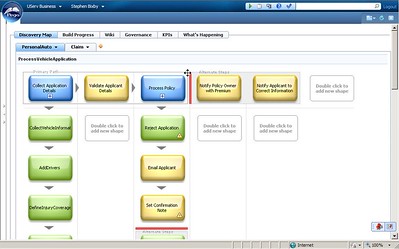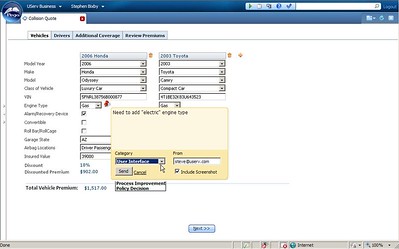We started after the break with Jeremy Westerman, head of BPM product marketing for TIBCO, presenting on AMX BPM. The crowd is a bit slow returning, which I suspect is due more to the availability of Wii Hockey down the hall than to the subject matter. Most telling, Westerman has the longest timeslot of the day, 45 minutes, which shows the importance that TIBCO is placing on marketing efforts for this new generation of their BPM platform. As I mentioned earlier, I’ve had 3+ hours of briefing on AMX BPM recently and think that they’ve done a good job of rearchitecting – not just refactoring – their BPM product to a modern architecture that puts them in a good competitive position, assuming that they can get the customer adoption. He started by talking about managing business processes as strategic assets, and the basics of what it means to move processes into a BPMS, then moved on to the TIBCO BPM products: Business Studio for modeling, the on-premise AMX BPM process execution environment, and the cloud-based Silver BPM process execution environment. This built well on their earlier messages about integration and SOA, since many business processes – especially for the financial-biased audience here today – are dependent on integrating data and messaging with other enterprise systems. Business-friendly is definitely important for any BPM system, but the processes also have to be able to punch at enterprise weight.
His explanation of work management also covered optimizing people within the process: maximizing utilization while still meeting business commitments through intelligent routing, unified work lists and process/work management visibility. A BPM system allows a geographically distributed group of resources to be treated as single pool for dynamic tunable work management, so that the actual organizational model can be used rather than an artificial model imposed by location or other factors. This led into a discussion of workflow patterns, such as separation of duties, which they are starting to build into AMX BPM as I noted in my recent review. He walked through other functionality such as UI creation, analytics and event processing; although I’ve seen most of this before, it was almost certainly new to everyone except the few people in the room who had attended TUCON back in May. The BPM booth was also the busiest one during the break, indicating a strong audience interest; I’m sure that most BPM vendors are seeing this same level of interest as organizations still recovering from the recession look to optimize their processes to cut costs and provide competitive advantage.
Ivan Casanova, director of cloud marketing for TIBCO, started with some pretty simple Cloud 101 stuff, then outlined their Silver line of cloud platforms: Silver CAP for developing cloud services, Silver Fabric for migrating existing applications, Silver BPM for process management, and Silver Spotfire for analytics. Some portion of the IT-heavy audience was probably thinking “not in my data centre, dude!”, but eventually every organization is going to have to think about what a cloud platform brings in terms of speed of deployment, scalability, cost and ability to collaborate outside the enterprise. Although he did talk about using Fabric for “private cloud” deployments that leverage cloud utility computing principles for on-premise systems, he didn’t mention the most likely baby step for organizations who are nervous about putting production data in the cloud, which is to use the cloud for development and testing, then deploy on premise. He finished with a valid point about how they have a lot of trust from their customers, and how they’ve built cloud services that suit their enterprise customers’ privacy needs; IBM uses much the same argument about why you want to use an large, established, trusted vendor for your cloud requirements rather than some young upstart.
We then heard from Greg Shevchik, a TIBCO MDM specialist, for a quick review of the discipline of master data management and TIBCO’s Collaborative Information Manager (CIM). CIM manages the master data repositories shared by multiple enterprise systems, and allows other systems – such as AMX BPM – to use data from that single source. It includes a central data repository; governance tools for validation and de-duplication; workflow for managing the data repository; synchronization of data between systems; and reporting on MDM.
Last up for the Toronto TIBCO Now was Al Harrington (who was the mystery man who opened the day), giving us a quick view of the new generation of TIBCO’s CEP product, BusinessEvents. There’s a lot to see here, and I probably need to get a real briefing to do it justice; events are at the heart of so many business processes that CEP and BPM are becoming ever more intertwined.
My battery just hit 7% and we’re after 5pm, so I’ll wrap up here. The TIBCO Now roadshow provides a good overview of their updated technology portfolio and the benefits for customers; check for one coming your way.





